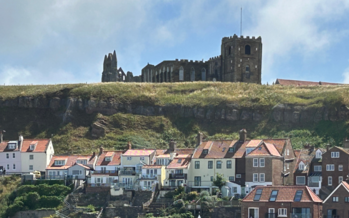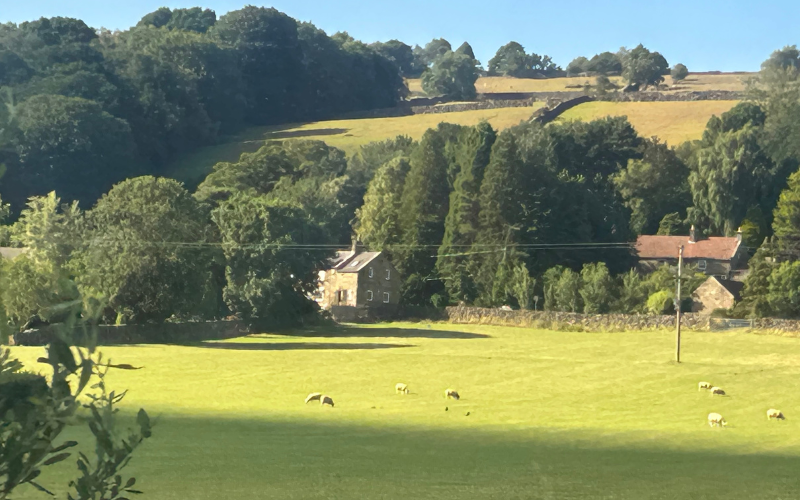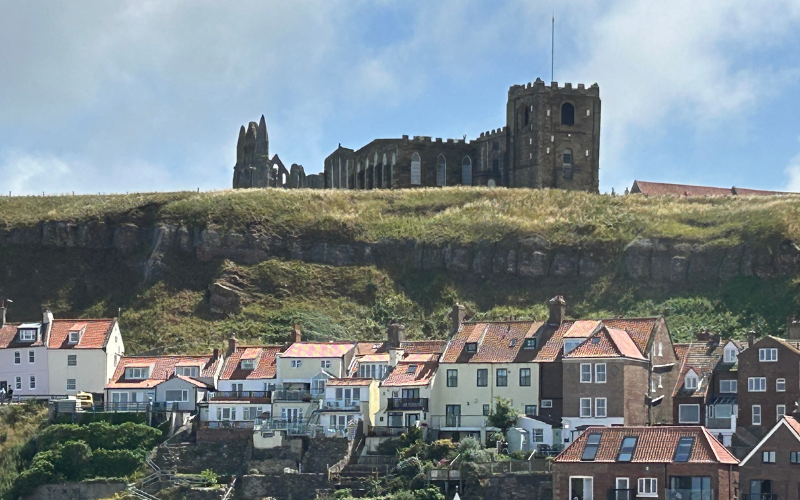-
 July 22, 2025By Bishop Gerald Kicanas
July 22, 2025By Bishop Gerald Kicanas
We left Northern Ireland for a visit to Northern England, especially in the Yorkshire District including Leeds, York, Whitby, Harrogate and Newcastle. The district is a lush green area of vast wheat fields with sheep, cattle and horses grazing on the land. We centered in Leeds, a bustling city of shops and restaurants with a central railway station, serving the whole Yorkshire District easily.
Train service in England is very organized and on time except for our trip to Whitby on the coast of the North Sea which nearly stranded us in the small seaside town because of train trouble. Happily, we did make it back to our hotel in Leeds, but much later than expected. Travel always involves some surprises.
Our first visit in Yorkshire District was to York, a walled city that goes back in time to the Romans about 71 AD. The Roman army invaded Yorkshire area and established a fort between the rivers Ouse and Foss. A small town emerged by the fort. It allowed merchants to sell their wares to the soldiers and the river Ouse allowed ships to sail up to the town. At that time York was known as Eboracum. Anglo Saxon York began in the 7th century on the ruins of the Roman town, which had fallen into ruin. During that time the magnificent York Minster was built within the city walls. That massive Cathedral still towers over the city. In the 9th century the Vikings captured York and renamed it Jorvik. As you walk around the town many of the streets still bear the Viking names. It later became England’s second largest city, thriving on the wool trade and the York Minster became a powerful seat of the Church of England. Today the city has preserved much of its medieval architecture and its well-preserved walls that we had a chance to walk around.
The narrow streets of York are lined with all kinds of different shops. Shambles is one of the most famous of those streets where you might even find different sculptures of cats on the store tops or invitations to encounter the ghosts that lurk in the city.
The rise and fall of nation states is fascinating as you see remnants of all those who occupied this place. It causes you to reflect on our own day and the passing of even the greatest of empires.
As Psalm 103 says, “As for man, his days are like the grass, he blossoms like a flower in the field, a wind sweeps over it and it is gone, its place knows it no more.” Or Psalm 144 “Man is but a breath, his days are like a passing shadow.”Or Psalm 90 “Lord you have been our refuge through all generations…a thousand years in your eyes are merely a day gone by…In the morning, it blossoms only to pass away: in the evening it is wilted and withered.”
 We visited a small, picturesque seaside village of Whitby almost two hours by train from Leeds. The village is packed with visitors many walking their dogs as the city is one of the friendliest for dog lovers. There are the ruins of the ancient, abandoned, gothic Whitby abbey atop the clifftop, eerily overlooking the village bustling with people. The town is famous for Bram Stoker’s novel, Dracula. The fictional character is not buried there but the town capitalizing on the book’s storyline. Captain John Cook (1728-1779) is also from the area. He fell in love with the sea. He charted the coast of New Zealand and the eastern coast of Australia. He is one of the most famous sailors and adventurers of all time.
We visited a small, picturesque seaside village of Whitby almost two hours by train from Leeds. The village is packed with visitors many walking their dogs as the city is one of the friendliest for dog lovers. There are the ruins of the ancient, abandoned, gothic Whitby abbey atop the clifftop, eerily overlooking the village bustling with people. The town is famous for Bram Stoker’s novel, Dracula. The fictional character is not buried there but the town capitalizing on the book’s storyline. Captain John Cook (1728-1779) is also from the area. He fell in love with the sea. He charted the coast of New Zealand and the eastern coast of Australia. He is one of the most famous sailors and adventurers of all time. In Ireland and England, the Church as elsewhere has lost many people because of the revelation of the tragic abuse done to children by members of the clergy and others connected with the Church. Vocations in both places as elsewhere have fallen significantly and many churches are abandoned. As I looked at the remnants of the Whitby Abbey one wonders how the church will recover, how we will restore trust that has been broken. Yet as we witnessed the grief and sadness of countless people around the world and the worldwide fascination about the election of our new Holy Father, Pope Leo XIV, clearly the church is an institution that still fascinates people. Trust will be restored little by little as the Church lives out the mission entrusted to her by Christ to preach good news to the poor, to proclaim liberty to captives, release to prisoners. Pope Francis and now Pope Leo are encouraging the Church to protect and uphold the human dignity of every person, to stand with the poor and marginalized, to be a field hospital caring with compassion for all those struggling and in need. These are steps to restoring trust. Throughout the history of the church there have been countless scandals, but the church has rebounded mainly by the lives of holy women and men who have reminded us by their lives of what it means to be a follower of Christ.
In Ireland and England, the Church as elsewhere has lost many people because of the revelation of the tragic abuse done to children by members of the clergy and others connected with the Church. Vocations in both places as elsewhere have fallen significantly and many churches are abandoned. As I looked at the remnants of the Whitby Abbey one wonders how the church will recover, how we will restore trust that has been broken. Yet as we witnessed the grief and sadness of countless people around the world and the worldwide fascination about the election of our new Holy Father, Pope Leo XIV, clearly the church is an institution that still fascinates people. Trust will be restored little by little as the Church lives out the mission entrusted to her by Christ to preach good news to the poor, to proclaim liberty to captives, release to prisoners. Pope Francis and now Pope Leo are encouraging the Church to protect and uphold the human dignity of every person, to stand with the poor and marginalized, to be a field hospital caring with compassion for all those struggling and in need. These are steps to restoring trust. Throughout the history of the church there have been countless scandals, but the church has rebounded mainly by the lives of holy women and men who have reminded us by their lives of what it means to be a follower of Christ. Our final visits in Yorkshire District were to Harrogate and Newcastle both beautiful cities with much to see. Harrogate is famous for its gardens, flowers everywhere. It is a beautiful place. Beauty is a way of encountering God who is beauty itself. When we look around this immense universe and the magnificence of God’s creation, we can only wonder about this good and gracious God who has created all of life.
Our final visits in Yorkshire District were to Harrogate and Newcastle both beautiful cities with much to see. Harrogate is famous for its gardens, flowers everywhere. It is a beautiful place. Beauty is a way of encountering God who is beauty itself. When we look around this immense universe and the magnificence of God’s creation, we can only wonder about this good and gracious God who has created all of life.
I am grateful for this time away and look forward to coming home to Tucson as we continue to wait for our Holy Father’s appointment of our next bishop.Keep praying!
